Hydrodynamic Modeling of a Large, Shallow Estuary
Abstract
:1. Introduction
2. Model Setup
2.1. Model Grid
2.2. External Forcings
3. Hydrodynamic Model Calibration
3.1. Tidal Water Surface Elevation
3.2. Low-Frequency Water Surface Elevation
3.3. Tidal Currents
- (1)
- Station IDs 1 through 9 correspond to locations in the Florida Straits (to the south of the Keys). Observed tidal current amplitudes in this area are less than 5 cm/s. The model simulation is judged as good for amplitudes and fair for phases and orientations.
- (2)
- Stations with IDs 11 through 19 represent major openings between the western region of the bay and the straits. Current amplitudes at these stations are relatively large, between 25 and 90 cm/s. Model simulations of amplitudes, phases, and orientations are quite good, with phases within approximately 20 min or less and angles within 26 degrees or less. Considering that the modeled velocities are averages over 105 to 106 km2 and are compared to a single-point current measurements, the agreement of amplitudes is adequate.
- (3)
- Stations with IDs 20 through 24 represent the southwest region of the bay. Agreement between amplitudes at these stations is again adequate. With the exception of Station 24, phase differences are less than 20 min, and angle differences are less than 7 degrees.
- (4)
- Stations with IDs 25 through 32 represent the western central region of the bay. Agreement at Stations 25 and 26 is good. Agreement at Stations 27 through 32 is much more variable due to the influence of banks and local features controlling current dynamics.
- (5)
- Stations 33, 34, 37, and 38 are representative of the southwest coastal shelf outside of Florida Bay. At the two southern stations, 33 and 34, the current amplitudes are simulated well, and the phases and angles are within approximately 12 min and 22 degrees. At the northern station 37, which is on the model’s open boundary, the simulated currents agree well with the observed data, while the phase error is on the order of 1 h. Angular error at this station is a low 6 degrees. Amplitude and angle agreement at Station 38 is exceptionally good and the phase error is less than 25 min.
- (6)
- At Stations 35 and 36, the model tends to underpredict current amplitudes in this region but does exceptionally well with respect to phase and angle.
- (7)
- Stations with IDs 39 through 42 represent the Whipray Basin region of the central Florida Bay. Although the model calculates the appropriate magnitudes of the relatively low current amplitudes, agreements in phase and direction are quite variable and likely associated with bathymetric features that are not well resolved in the grid.
| Station | ID | Observed Major Axis (cm/s) | Modeled Major Axis (cm/s) | Observed Phase at Major (min) | Modeled Phase at Major (min) | Observed Major Direction (Degree) | Modeled Major Direction (Degree) |
|---|---|---|---|---|---|---|---|
| Tennessee | 1 | 4.3 | 6.1 | 316.8 | 235.2 | 17 | 71 |
| Allig Reef | 2 | 3.3 | 3.5 | 21.0 | 121.2 | 42 | 64 |
| Hawk IM | 3 | 3.3 | 3.5 | 304.5 | 471.0 | 36 | 99 |
| Triangles | 4 | 3.3 | 4.7 | 366.2 | 485.5 | 79 | 116 |
| Conch Reef | 5 | 4.9 | 5.9 | 15.7 | 121.3 | 58 | 103 |
| Molasses | 6 | 5.0 | 5.4 | 14.0 | 104.2 | 54 | 104 |
| Hawk MK | 7 | 3.6 | 3.4 | 197.8 | 130.2 | 38 | −50 |
| Pacific Rf | 8 | 3.1 | 4.4 | 411.8 | 247.7 | 81 | 67 |
| MKR 4 Hk | 9 | 2.0 | 6.2 | 96.8 | 222.5 | 62 | 63 |
| NW Chan | 10 | 65.9 | 59.7 | 200.3 | 165.0 | 120 | 84 |
| 7 MiBr 7 | 11 | 27.4 | 45.0 | 274.3 | 264.7 | 122 | 112 |
| 7 MiBr 5 | 12 | 35.1 | 55.7 | 284.3 | 272.0 | 98 | 100 |
| 7 MiBr 3 | 13 | 43.7 | 50.4 | 287.2 | 281.2 | 118 | 95 |
| 7 MiBr 2 | 14 | 63.6 | 57.3 | 291.5 | 287.8 | 103 | 79 |
| Moser | 15 | 52.8 | 50.4 | 296.7 | 281.2 | 94 | 95 |
| Knight Ky | 16 | 89.4 | 57.3 | 292.7 | 287.8 | 54 | 79 |
| Long Ky | 17 | 54.8 | 59.1 | 299.3 | 312.8 | 137 | 163 |
| Indian Key | 18 | 47.4 | 24.3 | 242.0 | 294.8 | 135 | 125 |
| Tea Table | 19 | 45.8 | 24.3 | 248.0 | 294.8 | 94 | 124 |
| 8105 S | 20 | 15.3 | 17.3 | 278.5 | 282.7 | 82 | 84 |
| S South | 21 | 8.4 | 16.6 | 320.0 | 322.2 | 48 | 47 |
| Chan Key | 22 | 42.3 | 32.2 | 320.8 | 304.3 | 171 | 175 |
| Long Ky | 23 | 45.9 | 27.5 | 304.9 | 314.8 | 112 | 119 |
| Yacht Ch | 24 | 44.1 | 23.5 | 226.7 | 310.7 | 37 | −39 |
| 8015 C | 25 | 27.4 | 24.1 | 179.0 | 195.3 | 144 | 146 |
| S-Central | 26 | 20.0 | 23.1 | 204.9 | 211.0 | 130 | 138 |
| Rabbit Ky | 27 | 41.4 | 22.9 | 373.8 | 317.7 | 7 | 3 |
| S Twin Ky | 28 | 56.9 | 16.2 | 406.4 | 353.2 | 148 | 140 |
| Gopher Ky | 29 | 45.9 | 14.9 | 408.2 | 359.5 | 166 | 154 |
| Spy Key | 30 | 3.3 | 9.4 | 451.0 | 329.3 | 4 | 25 |
| N Central | 31 | 19.6 | 27.3 | 154.4 | 168.5 | 161 | 158 |
| N Central | 32 | 4.5 | 8.2 | 451.6 | 325.3 | −40 | 7 |
| NOAA B | 33 | 27.0 | 33.4 | 386.7 | 377.5 | −19 | 3 |
| NOAA A | 34 | 28.2 | 31.9 | 427.0 | 415.5 | 2 | 4 |
| 8105 N | 35 | 38.9 | 26.7 | 147.2 | 144.3 | 167 | 174 |
| Flamingo | 36 | 36.4 | 19.8 | 216.5 | 216.5 | 5 | 0 |
| NOAA D | 37 | 24.6 | 32.9 | 396.2 | 323.7 | 166 | 160 |
| NOAA C | 38 | 24.6 | 25.9 | 407.2 | 383.7 | 2 | 12 |
| Crock D | 39 | 0.3 | 2.0 | 210.5 | 82.3 | 114 | 159 |
| Dump W | 40 | 1.6 | 3.5 | 307.0 | 92.7 | 81 | 68 |
| Topsy D | 41 | 0.2 | 4.0 | 428.5 | 269.0 | 125 | 68 |
| Twisty W | 42 | 0.3 | 2.7 | 57.8 | 165.7 | 169 | 109 |
3.4. Temperature Calibration
3.5. Salinity Calibration
4. Impacts of Open Boundary Forcings and Grid Resolution
4.1. Interfacing with Another Ocean Model
4.2. Grid Resolution Analysis
5. Summary and Conclusions
- Based on the EFDC model, the three-dimensional hydrodynamic model of Florida Bay was calibrated using a comprehensive dataset, including measurements over 7 years at 34 tidal stations, 42 current stations, and 14 temperature and salinity stations. Overall, the FBM simulated tides, low-frequency surface water elevation, current, temperature, and salinity reasonably well.
- Florida Bay exhibits a shift in the tidal regime, transitioning from macro-tidal in the western region to micro-tidal in the central and eastern/northeast regions. Shallow water depth (less than 1 m on average) and complex banks and shoals attenuate tides. Local winds and the subtidal variations from the Gulf of Mexico and the Florida Straits are the primary drivers for the hydrodynamic processes in the eastern and central regions.
- Salinity changes in the bay, both temporally and spatially, are primarily controlled by three processes: the net supply of freshwater, the processes that drive mixing within the estuary (e.g., wind, topography, currents), and the exchange of salinity with the coastal ocean.
- Open boundary conditions from another ocean model with a larger domain (HYCOM in this study) can be adequate for simulating low-frequency sea level variability and salinity in the interior of Florida Bay when observational wind forcing fields are utilized.
- Grid sensitivity tests revealed that two vertical layers are necessary to simulate the bay. The use of four vertical layers and/or the fine horizontal grid did not significantly improve model accuracy.
Author Contributions
Funding
Institutional Review Board Statement
Informed Consent Statement
Data Availability Statement
Acknowledgments
Conflicts of Interest
References
- Ji, Z.-G. Hydrodynamics and Water Quality: Modeling Rivers, Lakes, and Estuaries, 2nd ed.; JohnWiley & Sons, Inc.: Hoboken, NJ, USA, 2017. [Google Scholar]
- Ganju, N.K.; Brush, M.J.; Rashleigh, B.; Aretxabaleta, A.L.; Del Barrio, P.; Grear, J.S.; Harris, L.A.; Lake, S.J.; McCardell, G.; O’Donnell, J.; et al. Progress and challenges in coupled hydrodynamic-ecological estuarine modeling. Estuaries Coasts 2016, 39, 311–332. [Google Scholar] [CrossRef]
- Iglesias, I.; Bio, A.; Melo, W.; Avilez-Valente, P.; Pinho, J.; Cruz, M.; Gomes, A.; Vieira, J.; Bastos, L.; Veloso-Gomes, F. Hydrodynamic model ensembles for climate change projections in estuarine regions. Water 2022, 14, 1966. [Google Scholar] [CrossRef]
- Iglesias, I.; Avilez-Valente, P.; Bio, A.; Bastos, L. Modelling the main hydrodynamic patterns in shallow water estuaries: The Minho Case Study. Water 2019, 18, 1040. [Google Scholar] [CrossRef]
- Hein, S.S.; Sohrt, V.; Nehlsen, E.; Strotmann, T.; Fröhle, P. Tidal Oscillation and Resonance in Semi-Closed Estuaries—Empirical Analyses from the Elbe Estuary, North Sea. Water 2021, 13, 848. [Google Scholar] [CrossRef]
- Zhang, M.L.; Zhu, X.S.; Wang, Y.J.; Jiang, H.Z.; Cui, L. A numerical study of hydrodynamic characteristics and hydrological processes in the coastal wetlands during extreme events. J. Hydrodyn. 2023, 35, 963–979. [Google Scholar] [CrossRef]
- Rudnick, D.T.; Ortner, P.B.; Browder, J.A.; Davis, S.M. A conceptual ecological model of Florida Bay. Wetlands 2005, 25, 870–883. [Google Scholar] [CrossRef]
- Wachnicka, A.; Gaiser, E.; Collins, L.; Frankovich, T.; Boyer, J. Distribution of diatoms and development of diatom-based models for inferring salinity and nutrient concentrations in Florida Bay and adjacent coastal wetlands of south Florida (USA). Estuaries Coasts 2010, 33, 1080–1098. [Google Scholar] [CrossRef]
- Kelble, C.R.; Johns, E.M.; Nuttle, W.K.; Lee, T.N.; Smith, R.H.; Ortner, P.B. Salinity patterns of Florida Bay. Estuar. Coast. Shelf Sci. 2007, 71, 318–334. [Google Scholar] [CrossRef]
- Lotze, H.K.; Lenihan, H.S.; Bourque, B.J.; Bradbury, R.H.; Cooke, R.G.; Kay, M.C.; Kidwell, S.M.; Kirby, M.X.; Peterson, C.H.; Jackson, J.B.C. Depletion, degradation, and recovery potential of estuaries and coastal seas. Sci. Mag. 2006, 312, 1806–1809. [Google Scholar] [CrossRef] [PubMed]
- McLean, A.R.; Ogden, J.C.; Williams, E.E. Comprehensive Everglades Restoration Plan; South Florida Water Management District: West Palm Beach, FL, USA, 2002.
- LoSchiavo, A.J.; Best, R.G.; Burns, R.E.; Gray, S.; Harwell, M.C.; Hines, E.B.; McLean, A.R.; St Clair, T.; Traxler, S.; Vearil, J.W. Lessons learned from the first decade of adaptive management in comprehensive Everglades restoration. Ecol. Soc. 2013, 18, 70. [Google Scholar] [CrossRef]
- D’Acunto, L.E.; Pearlstine, L.; Haider, S.M.; Hackett, C.E.; Shinde, D.; Romañach, S.S. The Everglades vulnerability analysis: Linking ecological models to support ecosystem restoration. Front. Ecol. Evol. 2023, 11, 1111551. [Google Scholar] [CrossRef]
- McAdory, R.T.; Kim, K.W. Field and Model Studies in Support of the Evaluation of Impacts of the C-111 Canal on Regional Water Resources, South Florida, Part IV: Florida Bay Hydrodynamic Modeling; US Army Corps of Engineers, Waterways Experiment Station: Vicksburg, MS, USA, 1998.
- Cerco, C.F.; Bunch, B.W.; Teeter, A.M.; Dortch, M.S. Water Quality Model of Florida Bay; Technical Report ERDC/EL TR-00-10; U.S. Army Corps of Engineers: Vicksburg, MS, USA, 2000.
- Wang, J.D.; van de Kreeke, J.; Krishnan, N.; Smith, D. Wind and Tide Response in Florida Bay. Bull. Mar. Sci. 1994, 54, 579–601. [Google Scholar]
- Wang, J.D. Subtidal Flow Patterns in Western Florida Bay. Estuar. Coast. Shelf Sci. 1998, 46, 901–915. [Google Scholar] [CrossRef]
- Sheng, Y.P.; Davis, J.R.; Liu, Y. A Preliminary Model of Florida Bay Circulation; Final Report to the National Park Service; University of Florida: Gainesville, FL, USA, 1995. [Google Scholar]
- Hamrick, J.M. A Three-Dimensional Environmental Fluid Dynamics Computer Code: Theoretical and Computational Aspects; Special Report 317; The College of William and Mary, Virginia Institute of Marine Science: Gloucester Point, VA, USA, 1992; 63p. [Google Scholar]
- Hamrick, J.M. Users Manual for the Environmental Fluid Dynamic Computer Code; Special Report 328; The College of William and Mary, Virginia Institute of Marine Science: Gloucester Point, VA, USA, 1996; 224p. [Google Scholar]
- Mellor, G.L.; Yamada, T. Development of a turbulence closure model for geophysical fluid problems. Rev. Geophys. Space Phys. 1982, 20, 851–875. [Google Scholar] [CrossRef]
- Galperin, B.; Kantha, L.H.; Hassid, S.; Rosati, A. A quasi-equilibrium turbulent energy model for geophysical flows. J. Atmos. Sci. 1988, 45, 55–62. [Google Scholar] [CrossRef]
- Ji, Z.G.; Morton, M.R.; Hamrick, J.M. Wetting and drying simulation of estuarine processes. Estuar. Coast. Shelf Sci. 2001, 53, 683–700. [Google Scholar] [CrossRef]
- Ji, Z.-G.; Hamrick, J.H.; Pagenkopt, J. Sediment and metals modeling in shallow river. J. Environ. Eng. 2002, 128, 105–119. [Google Scholar] [CrossRef]
- Ji, Z.-G.; Jin, K.R. Gyres and seiches in a large and shallow lake. J. Great Lakes Res. 2006, 32, 764–775. [Google Scholar] [CrossRef]
- Ji, Z.G.; Hu, G.; Shen, J.; Wan, Y. Three-dimensional modeling of hydrodynamic processes in the St. Lucie Estuary. Estuar. Coast. Shelf Sci. 2007, 73, 188–200. [Google Scholar] [CrossRef]
- Ji, Z.-G.; Jin, K.R. An integrated environmental model for a surface flow constructed wetland: Water quality processes. Ecol. Eng. 2016, 86, 247–261. [Google Scholar] [CrossRef]
- Tetra Tech, Inc. Florida Bay Hydrodynamic and Salinity Model Analysis; South Florida Water Management District: Fairfax, VA, USA, 2003; 92p.
- Tetra Tech, Inc. Development of a Florida Bay and Florida Keys Hydrodynamic and Water Quality Model: Grid Resolution Analysis; South Florida Water Management District: Fairfax, VA, USA, 2004; 137p.
- Langevin, C.D.; Swain, E.D.; Wang, J.D.; Wolfert, M.A.; Schaffranek, R.W.; Riscassi, A.L.; Bay, F. Development of Coastal Flow and Transport Models in Support of Everglades Restoration; US Geological Survey Fact Sheet 3130; US Geological Survey: Reston, VA, USA, 2004; pp. 3–6.
- U.S. Environmental Protection Agency. Technical Guidance Manual for Performing Waste Load Allocations, Book III Estuaries, Part 2, Application of Estuarine Waste Load Allocation Models; EPA 823-R-92-003; U.S. Environmental Protection Agency: Washington, DC, USA, 1990.
- Marsaleix, P.; Auclair, F.; Estournel, C. Considerations on open boundary conditions for regional and coastal ocean models. J. Atmos. Ocean. Technol. 2006, 23, 1604–1613. [Google Scholar] [CrossRef]
- Diederen, D.; Savenije, H.H.G.; Toffolon, M. The open boundary equation. Ocean Sci. Discuss. 2015, 12, 925–958. [Google Scholar]
- Liu, Z.; Gan, J. A modeling study of estuarine–shelf circulation using a composite tidal and subtidal open boundary condition. Ocean Model. 2020, 147, 101563. [Google Scholar] [CrossRef]
- Bleck, R. An oceanic general circulation model framed in hybrid isopycnic-cartesian coordinates. Ocean Modell. 2002, 37, 55–88. [Google Scholar] [CrossRef]
- Olvera-Prado, E.R.; Romero-Centeno, R.; Zavala-Hidalgo, J.; Moreles, E.; Ruiz-Angulo, A. Contribution of the wind, Loop Current Eddies, and topography to the circulation in the southern Gulf of Mexico. Ocean Dyn. 2023, 73, 597–618. [Google Scholar] [CrossRef]
- Andrejev, O.; Soomere, T.; Sokolov, A.; Myrberg, K. The role of the spatial resolution of a three-dimensional hydrodynamic model for marine transport risk assessment. Oceanologia 2011, 53, 309–334. [Google Scholar] [CrossRef]
- Hasan, G.J.; van Maren, D.S.; Cheong, H.F. Improving hydrodynamic modeling of an estuary in a mixed tidal regime by grid refining and aligning. Ocean Dyn. 2012, 62, 395–409. [Google Scholar] [CrossRef]
- Ralston, D.K.; Cowles, G.W.; Geyer, W.R.; Holleman, R.C. Turbulent and numerical mixing in a salt wedge estuary: Dependence on grid resolution, bottom roughness, and turbulence closure. J. Geophys. Res. Ocean. 2017, 122, 692–712. [Google Scholar] [CrossRef]
- Nwogwu, N.A.; Linhoss, A.C.; Alarcon, V.J.; Mickle, P.F.; Kelble, C.R. The Effect of grid resolution on hydrodynamic modeling of estuarine water surface elevation: Balancing efficiency and accuracy. In Proceedings of the OCEANS 2023-MTS/IEEE US Gulf Coast, Biloxi, MS, USA, 25–28 September 2023; pp. 1–10. [Google Scholar]
- Moustafa, M.Z.; Ji, Z.-G. Impacts of freshwater sources on salinity structure in a large, shallow estuary. Environments, 2024; submitted. [Google Scholar]
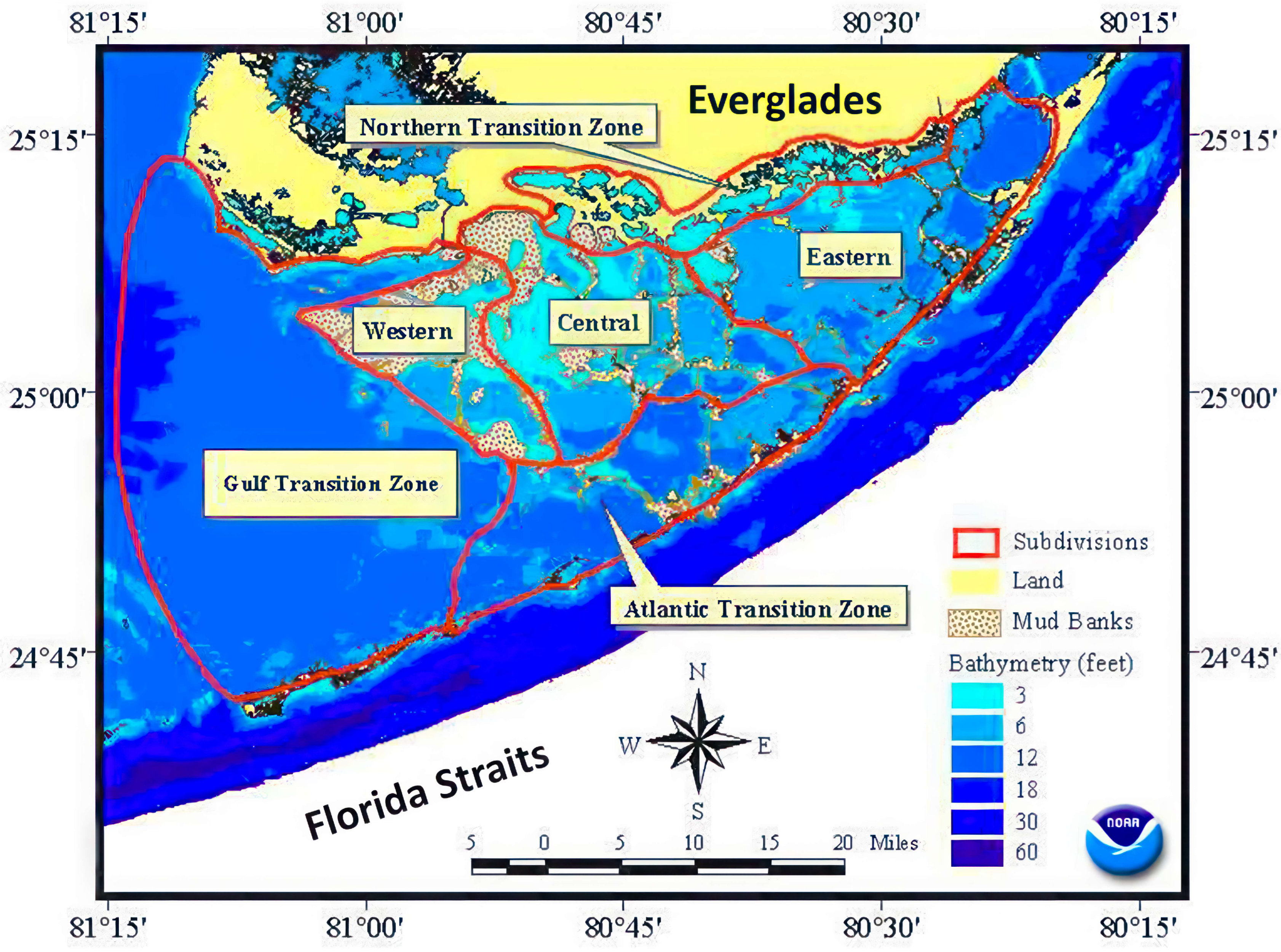
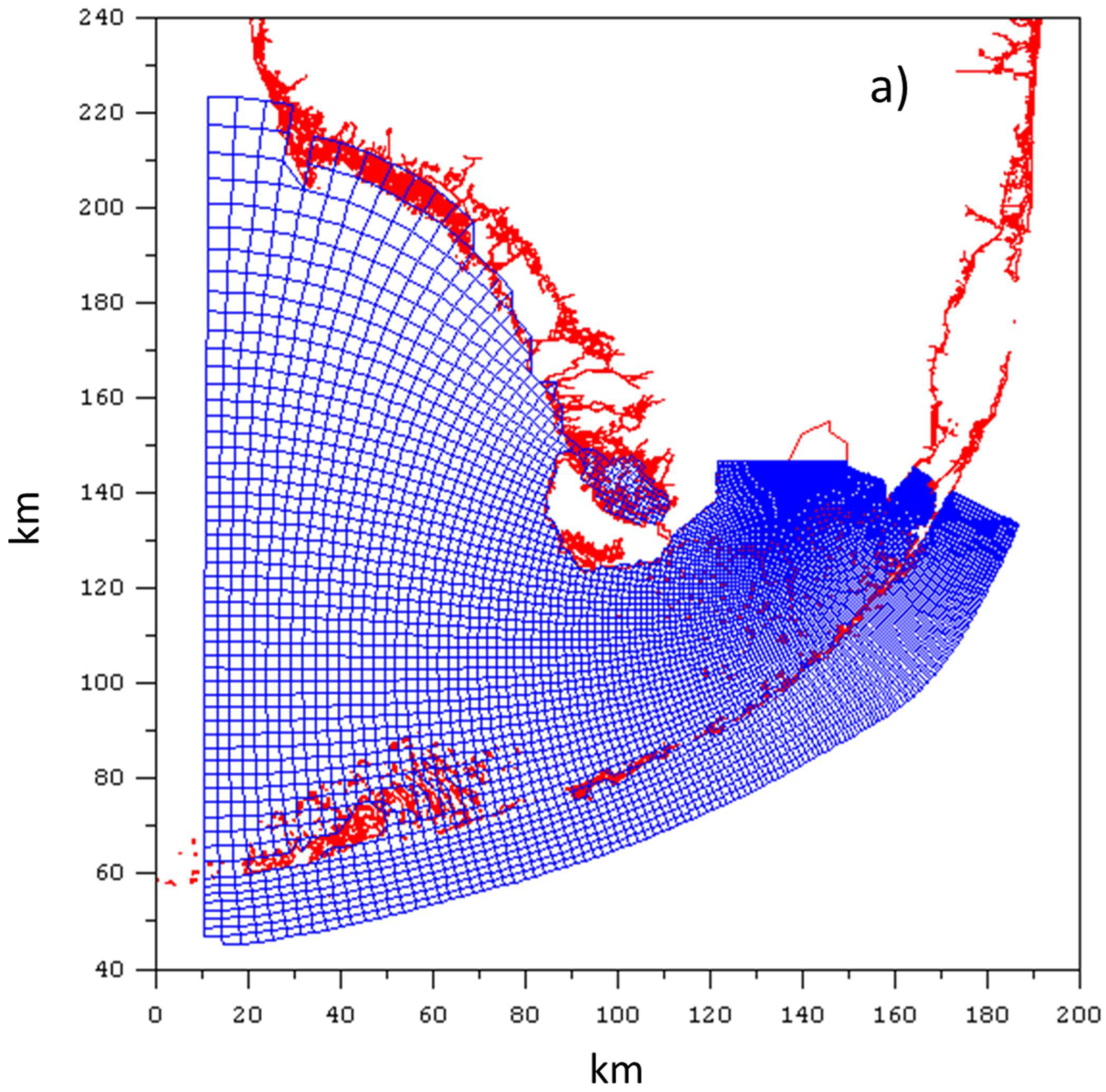
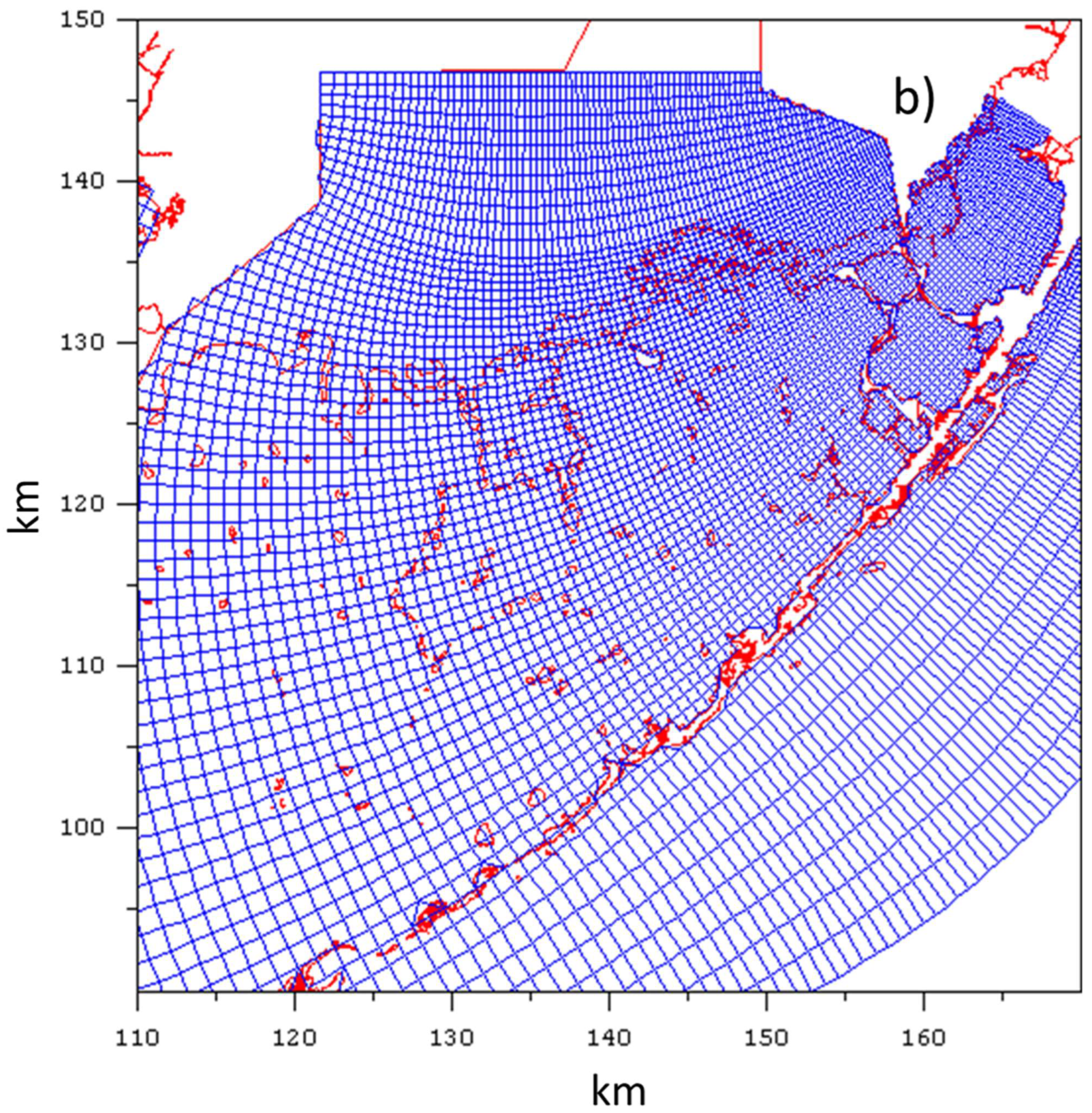
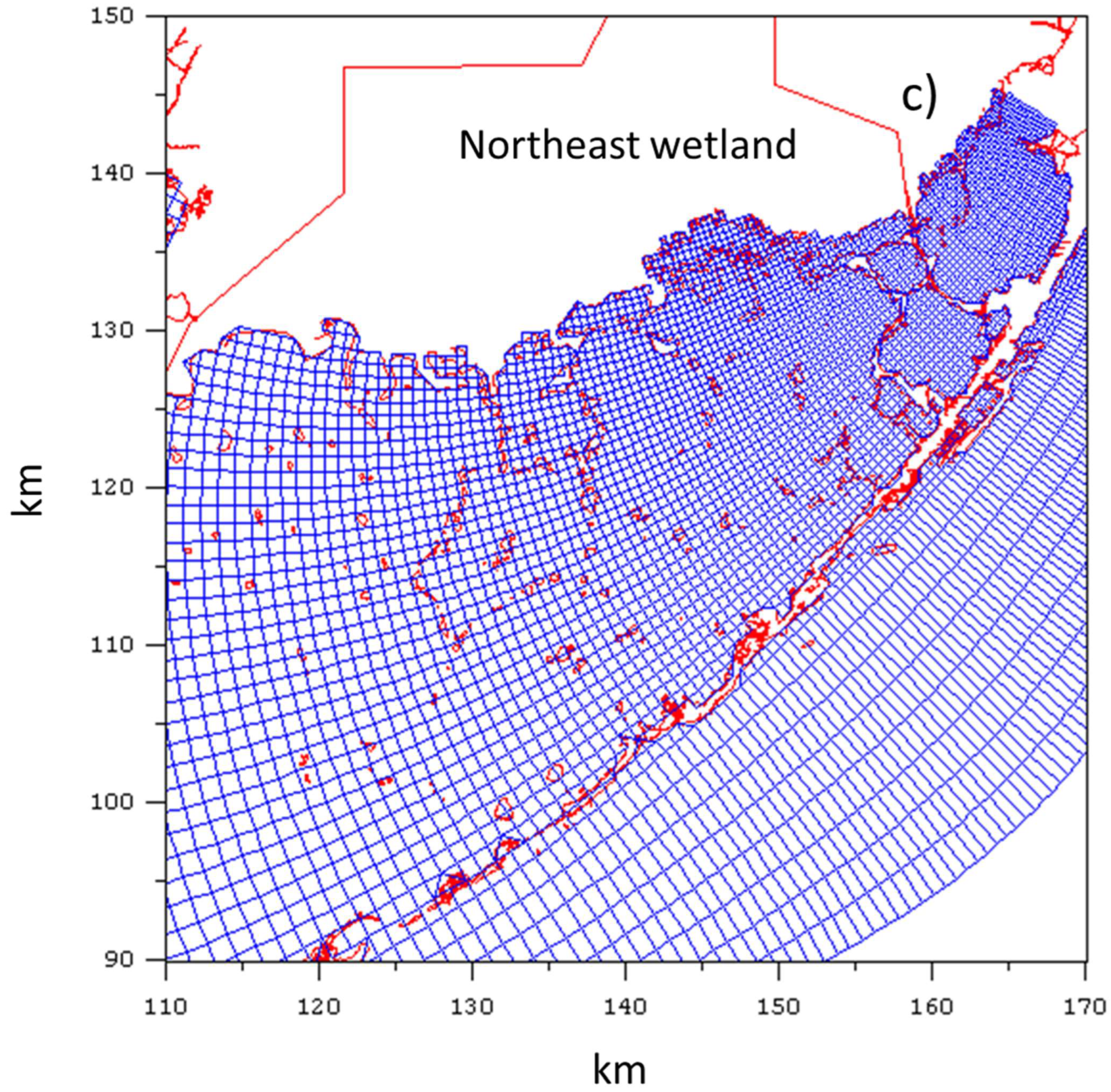
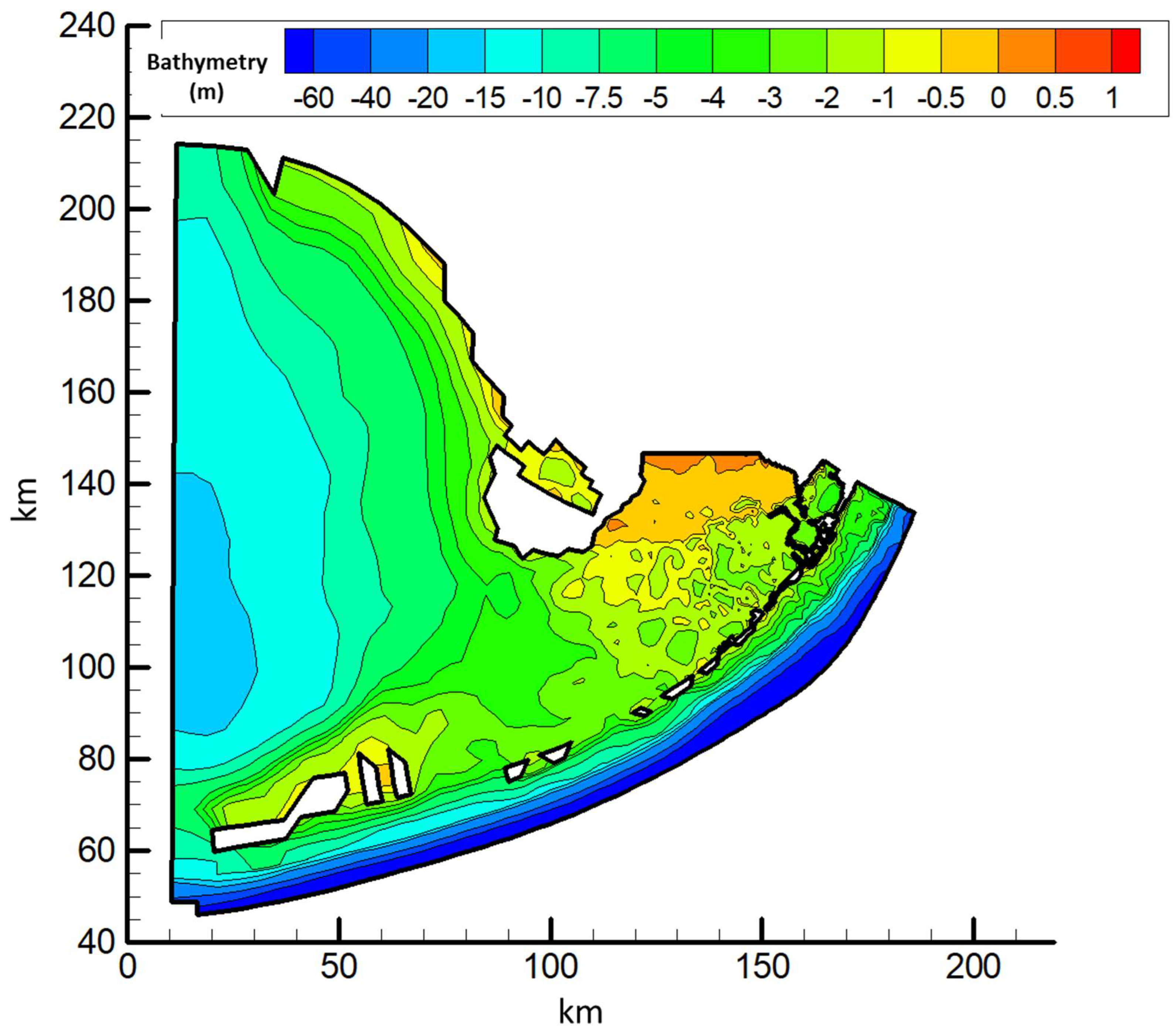
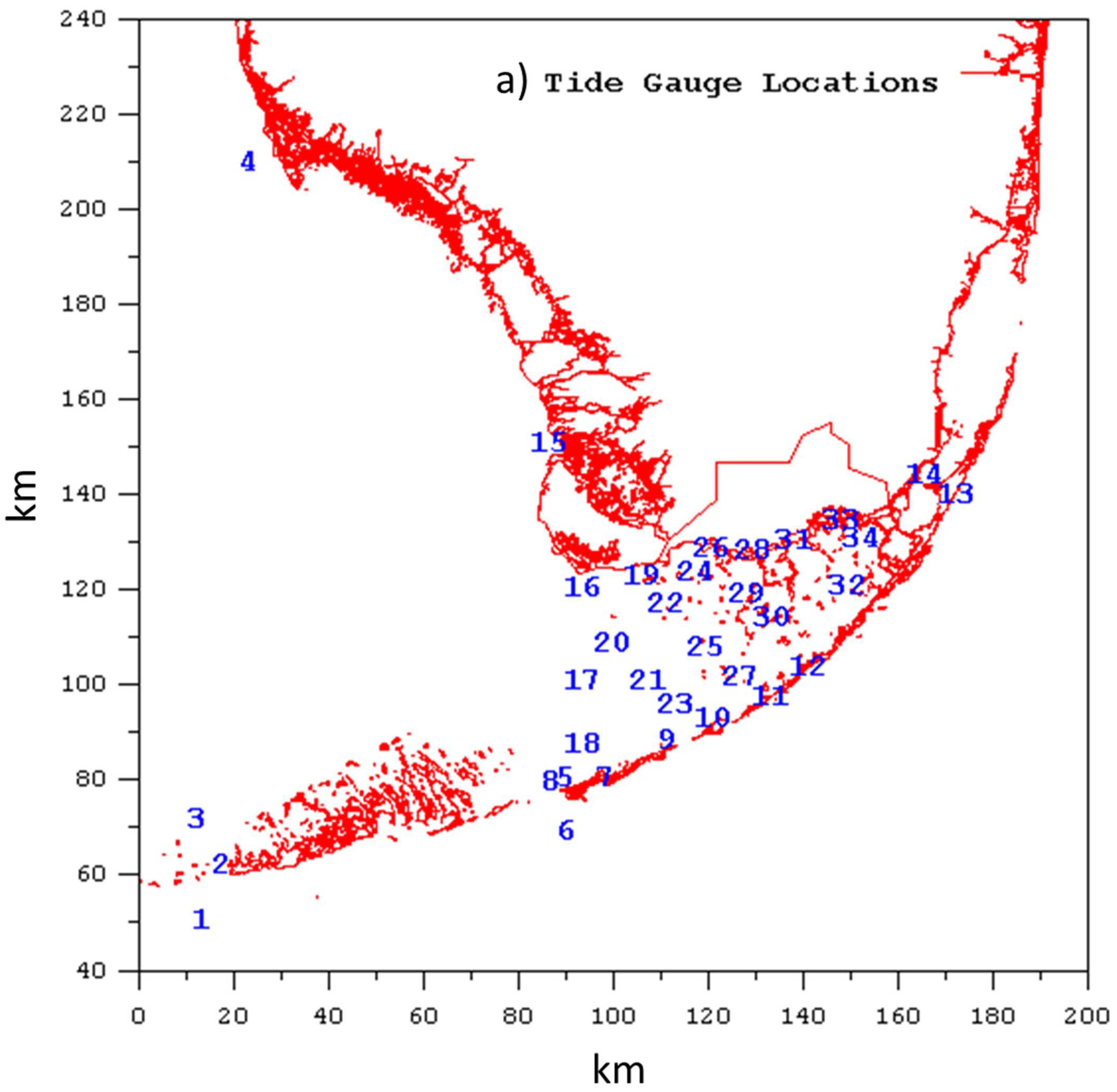

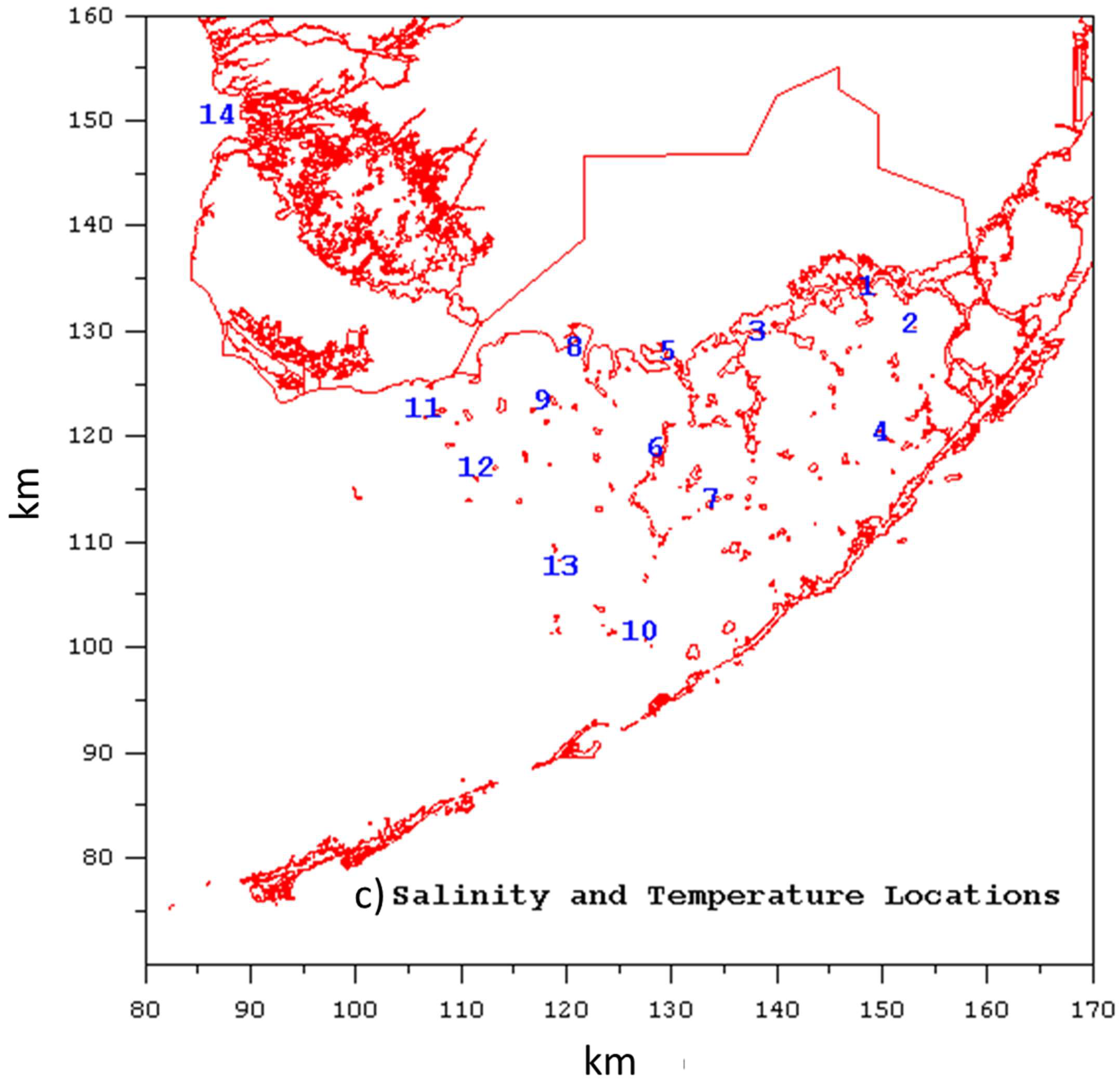
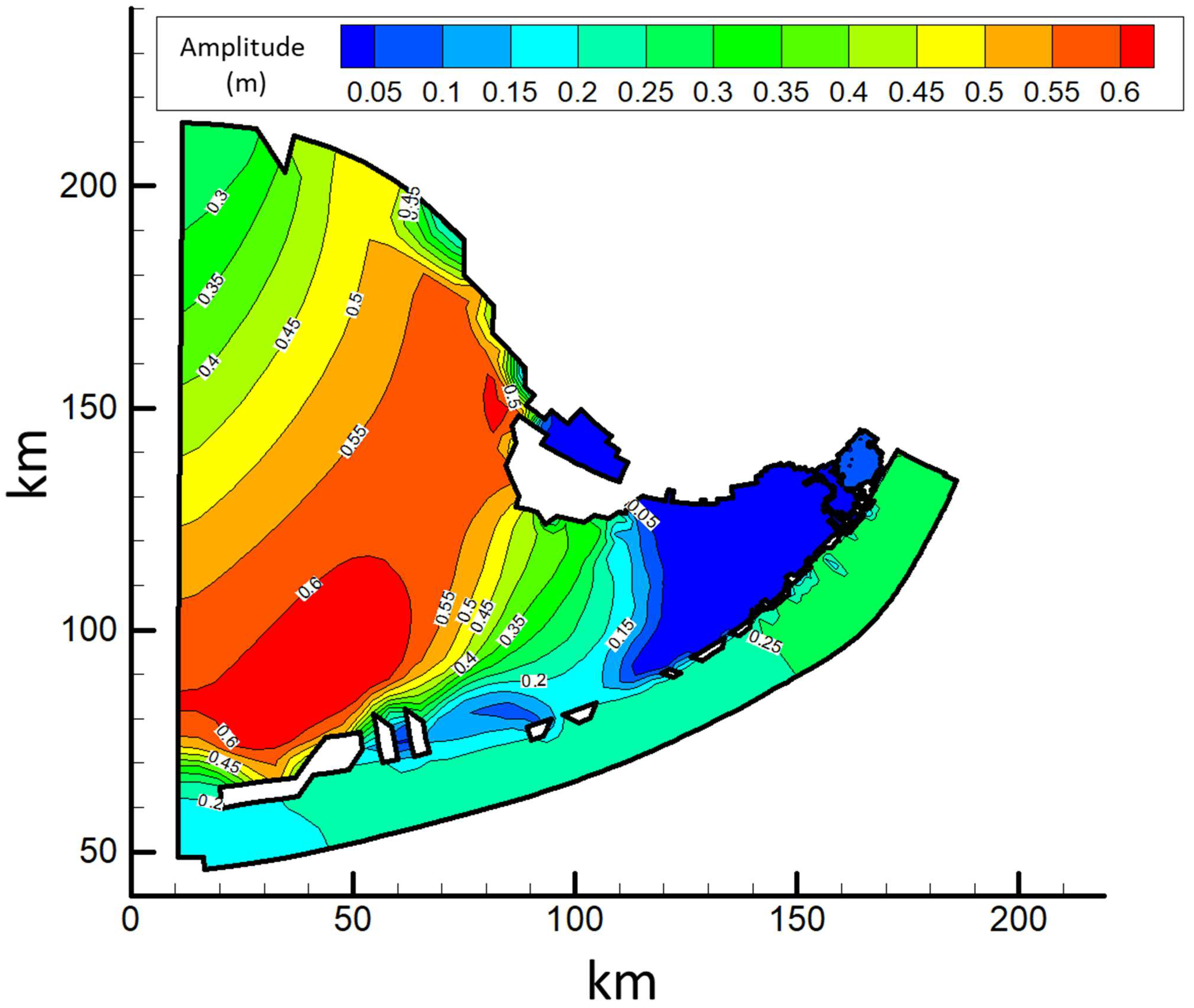
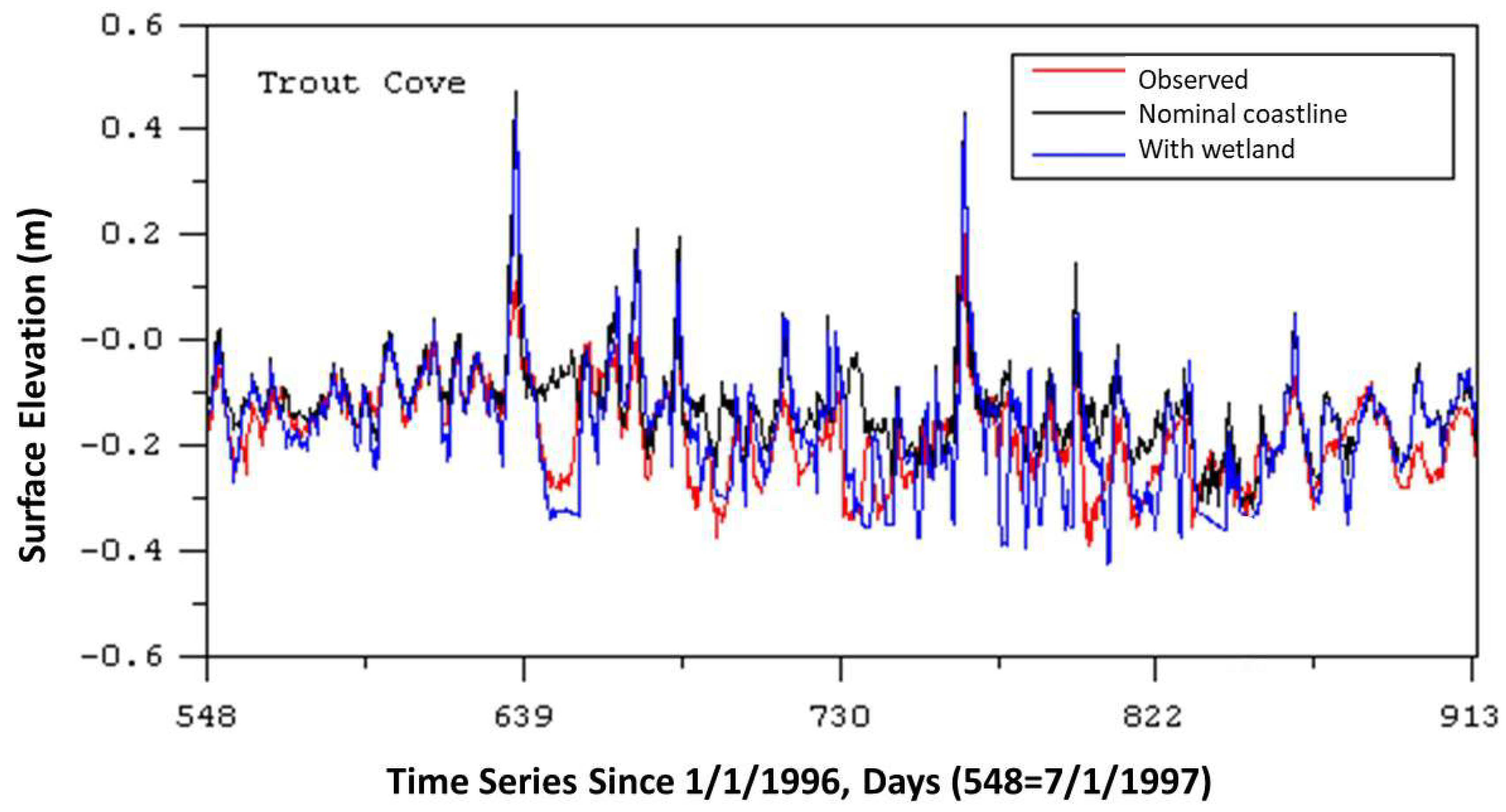




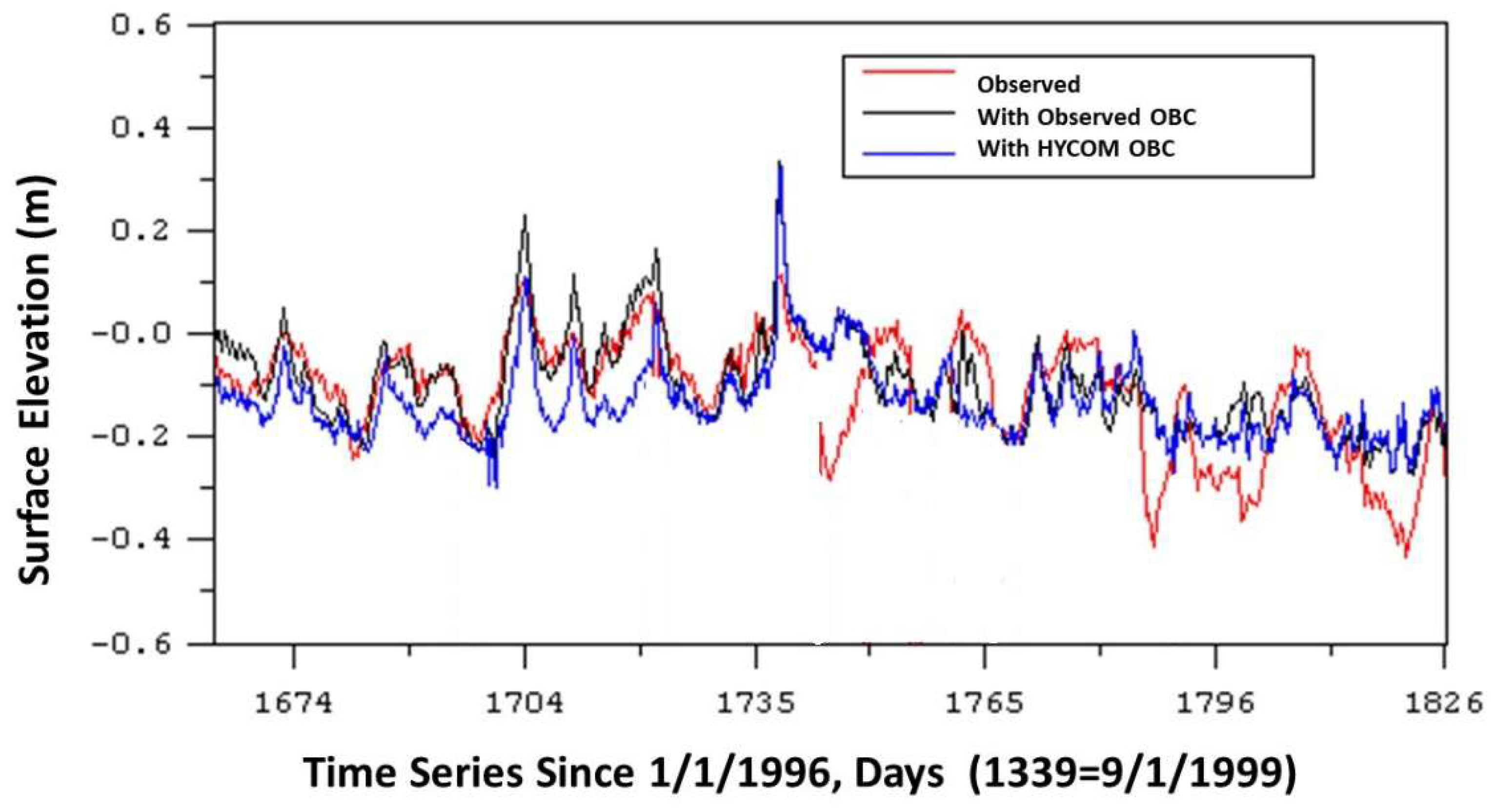
| Station | ID | Observed Amplitude (cm) | Modeled Amplitude (cm) | Normalized Amplitude Error (%) | Observed Phase (min) | Modeled Phase (min) | Phase Error (min) |
|---|---|---|---|---|---|---|---|
| Sand Key | 1 | 17.6 | 18.4 | 5 | 306.5 | 302.2 | 4.4 |
| Key West | 2 | 18.1 | 19.6 | 8 | 340.3 | 341.4 | −1.1 |
| Nav Aide | 3 | 36.8 | 41.4 | 13 | 469.7 | 449.4 | 20.3 |
| Naples | 4 | 27.4 | 28.1 | 3 | 498.5 | 500.3 | −1.7 |
| Vaca Key | 5 | 4.9 | 6.6 | 35 | 551.9 | 538.3 | 13.7 |
| SMK | 6 | 22.8 | 22.6 | 1 | 292.2 | 290.8 | 1.4 |
| Key Colony | 7 | 24.4 | 23.1 | 5 | 290.5 | 292.4 | −1.9 |
| TG05 | 8 | 4.8 | 11.3 | 135 | 356.1 | 342.0 | 14.1 |
| TG04 | 9 | 6.6 | 5.0 | 24 | 287.0 | 299.3 | −12.3 |
| TG03 | 10 | 6.5 | 1.5 | 77 | 326.2 | 363.8 | −37.6 |
| TG02 | 11 | 20.2 | 25.3 | 25 | 320.7 | 299.0 | 21.6 |
| TG01 | 12 | 13.8 | 26.0 | 88 | 304.5 | 300.0 | 4.4 |
| Ocean Reef | 13 | 27.2 | 30.9 | 14 | 305.1 | 290.4 | 14.7 |
| Barnes Sound | 14 | 8.8 | 8.7 | 1 | 533.6 | 534.6 | −1.0 |
| Shark River | 15 | 43.1 | 58.8 | 36 | 581.5 | 593.9 | −12.4 |
| 8105N | 16 | 39.5 | 38.0 | 4 | 596.1 | 609.3 | −13.2 |
| 8105C | 17 | 36.3 | 29.0 | 20 | 604.3 | 617.6 | −13.3 |
| 8105S | 18 | 23.4 | 18.3 | 22 | 628.9 | 623.4 | 5.5 |
| Murray | 19 | 32.6 | 29.4 | 10 | 692.4 | 673.3 | 19.1 |
| Oxfoot | 20 | 37.3 | 28.2 | 24 | 674.8 | 629.7 | 45.1 |
| Sprigger | 21 | 23.4 | 19.3 | 18 | 652.0 | 651.2 | 0.8 |
| Johnson | 22 | 20.0 | 16.4 | 18 | 726.0 | 710.9 | 15.1 |
| Arsenic | 23 | 6.6 | 7.0 | 6 | 647.8 | 646.0 | 1.8 |
| Buoy | 24 | 2.7 | 4.1 | 52 | 145.6 | 93.3 | 52.3 |
| Little Rabbit | 25 | 2.7 | 5.0 | 85 | 188.9 | 703.1 | −514.2 |
| Garfield | 26 | 1.7 | 2.3 | 35 | 264.6 | 150.7 | 113.9 |
| Little Peterson | 27 | 7.3 | 0.9 | 88 | 406.4 | 96.3 | 310.1 |
| Terrapin Bay | 28 | 0.4 | 1.6 | 300 | 643.8 | 157.8 | 486.0 |
| Whipray | 29 | 0.8 | 2.0 | 150 | 231.5 | 106.5 | 125.0 |
| Bob Allen | 30 | 4.6 | 0.7 | 85 | 427.1 | 143.3 | 283.8 |
| Lt Mader | 31 | 0.4 | 0.4 | 0 | 619.2 | 298.4 | 320.8 |
| Butternut | 32 | 0.5 | 0.4 | 20 | 592.9 | 285.2 | 307.7 |
| Trout Cove | 33 | 0.2 | 0.2 | 0 | 636.0 | 327.1 | 309.0 |
| Duck | 34 | 0.4 | 0.4 | 0 | 617.4 | 313.6 | 303.8 |
| Station/Configuration | Absolute Relative Error (%) | RMS Error (cm) |
|---|---|---|
| Trout Cove Nominal Coastline | 5.9 | 8.1 |
| Trout Cove Northeast Wetland | 6.6 | 8.7 |
| Terrapin Bay Nominal Coastline | 8.8 | 12.7 |
| Terrapin Bay Northeast Wetland | 8.6 | 12.5 |
| Station | ID | RMS Error With Nominal Coastline (°C) | RMS Error with Wetland (°C) | Normalized RMS Error with Nominal Coastline (%) | Normalized RMS Error with Wetland (%) |
|---|---|---|---|---|---|
| Trout Cove | 1 | 1.49 | 1.29 | 6 | 5 |
| Duck Key | 2 | 0.96 | 0.96 | 4 | 4 |
| Little Maderia Bay | 3 | 1.21 | 1.28 | 5 | 5 |
| Butternut Key | 4 | 1.92 | 1.91 | 7 | 7 |
| Terrapin Bay | 5 | 1.40 | 1.43 | 5 | 5 |
| Whipray | 6 | 1.47 | 1.47 | 5 | 5 |
| Bob Allen | 7 | 1.45 | 1.45 | 5 | 5 |
| Garfield | 8 | 2.92 | 2.89 | 11 | 11 |
| Buoy Key | 9 | 1.27 | 1.27 | 5 | 5 |
| Peterson | 10 | 1.32 | 1.33 | 5 | 5 |
| Murray | 11 | 3.48 | 3.47 | 13 | 13 |
| Johnson | 12 | 1.25 | 1.25 | 5 | 5 |
| Little Rabbit | 13 | 1.20 | 1.20 | 5 | 5 |
| Shark River | 14 | 1.25 | 1.25 | 5 | 5 |
| Station | ID | RMS Error With Nominal Coastline (ppt) | RMS Error with Wetland (ppt) | Normalized RMS Error with Nominal Coastline (%) | Normalized RMS Error with Wetland (%) |
|---|---|---|---|---|---|
| Trout Cove | 1 | 14.18 | 8.08 | 75 | 43 |
| Duck Key | 2 | 3.28 | 4.11 | 13 | 16 |
| Little Maderia Bay | 3 | 4.31 | 7.20 | 21 | 34 |
| Butternut Key | 4 | 3.93 | 5.27 | 14 | 18 |
| Terrapin Bay | 5 | 6.46 | 7.15 | 26 | 28 |
| Whipray | 6 | 4.04 | 5.64 | 12 | 17 |
| Bob Allen | 7 | 3.53 | 4.39 | 11 | 13 |
| Garfield | 8 | 6.32 | 15.11 | 21 | 50 |
| Buoy Key | 9 | 5.70 | 9.13 | 17 | 28 |
| Peterson | 10 | 2.89 | 2.94 | 8 | 9 |
| Murray | 11 | 4.39 | 5.61 | 14 | 17 |
| Johnson | 12 | 4.69 | 5.97 | 14 | 18 |
| Little Rabbit | 13 | 4.03 | 4.77 | 12 | 14 |
| Shark River | 14 | 5.88 | 6.10 | 24 | 25 |
Disclaimer/Publisher’s Note: The statements, opinions and data contained in all publications are solely those of the individual author(s) and contributor(s) and not of MDPI and/or the editor(s). MDPI and/or the editor(s) disclaim responsibility for any injury to people or property resulting from any ideas, methods, instructions or products referred to in the content. |
© 2024 by the authors. Licensee MDPI, Basel, Switzerland. This article is an open access article distributed under the terms and conditions of the Creative Commons Attribution (CC BY) license (https://creativecommons.org/licenses/by/4.0/).
Share and Cite
Ji, Z.-G.; Moustafa, M.Z.; Hamrick, J. Hydrodynamic Modeling of a Large, Shallow Estuary. J. Mar. Sci. Eng. 2024, 12, 381. https://doi.org/10.3390/jmse12030381
Ji Z-G, Moustafa MZ, Hamrick J. Hydrodynamic Modeling of a Large, Shallow Estuary. Journal of Marine Science and Engineering. 2024; 12(3):381. https://doi.org/10.3390/jmse12030381
Chicago/Turabian StyleJi, Zhen-Gang, M. Zaki Moustafa, and John Hamrick. 2024. "Hydrodynamic Modeling of a Large, Shallow Estuary" Journal of Marine Science and Engineering 12, no. 3: 381. https://doi.org/10.3390/jmse12030381





